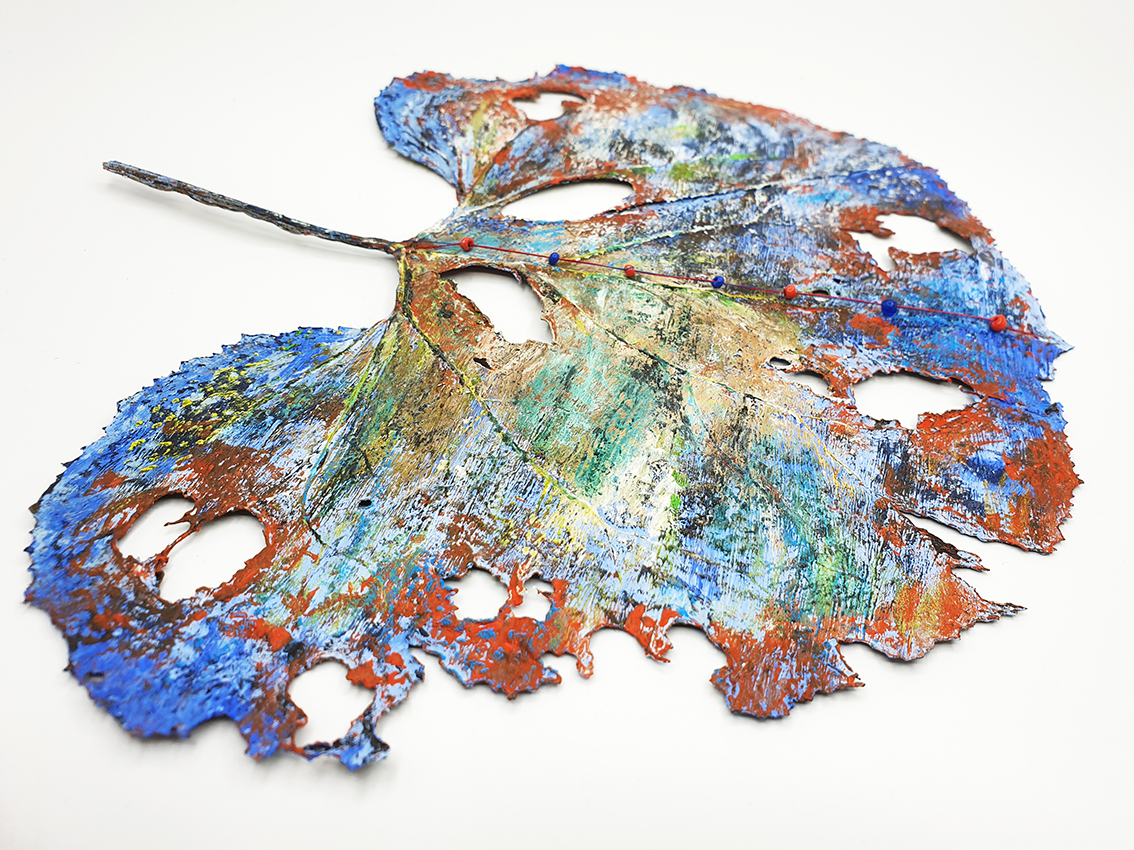by Achim Gnann
Angela Andorrer’s Handscapesare a fascinating, entirely individual art form, in which she paints a palm with watercolors, revealing or emphasizing the qualities and characteristics of a personality. After she hasprimed the palm with a neutral color, Angela Andorrer sets countless accents with thin colored brushstrokes. She covers thesurfaces and elevations with hatchings, traces the lines and accompanies them with strokes or dots. She works out the capillaries in such a way that, like fingerprints, they reveal the unmistakable personality structure. The hand lines often set a basic rhythm in their flow, which is accompanied by colored shapes or they form anetwork that encloses the color fields like a mosaic. The lines oftendig in and run through the hand like the course of a river.
Despitet heir abstraction, the paintings are reminiscent of maps or aerial photographs of landscapes from a great distance. No two works arealike, since the starting point is always the individual nature of a hand. In contrast to body painting, where patterns are projected on to the body, Angela Andorrer is always inspired by the uniqueness of the palm and never imposes decorative schemes on it.
The landscapes could not be more different. Sometimesthey resemble flowering fields, with plant-like formations sprouting here and there. Then again, they are barren, desert-like areas,criss-crossed by dry river courses, or mountains with rugged elevations, where greenery is scarcely possible, and between which rivers with icy water are wedged. Each of these hands is unique, and each one findsin its painted palm a trace of its personality or mood.
The painting process takes one to two hours. The artist looks at the hand under a magnifying glass, visualizes the special and intimate nature of the relief-like structure, texture and color of the skin and usually thinks for a while before deciding how to begin. Then she proceeds quite intuitively and lets herself be stimulated by the conversation with the sitter. A momentary mental mood sometimes influences the respective painting process, which has a performative character. Since the handscapes are transient, usually washed off again after a short time, Angela Andorrer captures them in large color prints, through which they are immortalized in the form of works of art. In the photos she works out the format and individual parts of the pictures, but does not change them significantly.
The artist also creates handscapesof couples, in which the merging of emotions, the unifying, but als othe separating elements become visible, as well as landscapes of several interlocking hands of a group or family. Angela Andorrer received significant inspiration for her art from her father, who wasa professor of cartography and an Antarctic researcher. She was also inspired by body and performance art, which she experimented with while studying art in Montreal in the 1990s. According to her own statements, she also is stimulated Dutch and French landscape painting of the 17th to 19th centuries.
Another area of her oeuvre are the Blattscapes . The artist collects unusual leaves in nature, which she then dries, presses and gums. She uses acrylic paints as well as yarn and pearls for the treatment. When painting, she is often inspired by the outerjagged, pointed or rounded shape of the leaves. Sometimes the colored brushstrokes expose the veins, making the filigree, vulnerable aspects of the leaf structure visible. Then again,the colors cover the ground, which are applied with broad brushstrokes in a picturesque style. Decorative patterns are distributed over the surfaces, between which threads can be stretched. As they are embroidered, they bring a different, haptic level of reality into play.
Often the leaves have holes that are bordered with red paint and then look like wounds. Threads run over these openings, but not to close them, but to span them like cobwebs. Angela Andorrer also enjoys such a textile embellishment of the leaves because her grandfather was a tailor and her mother owned a fabric shop. Often the artist also includes beads that are strung like on a necklace or lie on it like dewdrops or precious stones. The colored brush decoration, the taut threads and applied beads turn the leaves into sophisticated piece sof jewelry.
There spective form provides the inspiration and forms the starting point for the artistic transformation, but never completely covers or drowns out the sheet. The incomparable basic form always remains. Respect for the beauty and original state of the natural object takes precedence over artistic alienation.
Not infrequently, the threads that span the sheet, cross and branch out, are reminiscent of the streets and paths of a map. In this, the Blattcapes touch the Handscapes, which only at first glance have little in common with one another. Like the hands, leaves have a skin that protrudes and between themveins that are covered or highlighted by the brush. As with the hand, Angela Andorrer brings out the incomparable and individual in each individual leaf, so that none is like the other. Mounted in woodenboxes as if floating in front of a white background, these works of art unfold a wonderful life of their own.
What the artist moves in her work, she has formulated herself in a poetic way:
I travel on leaves and in strangers hands. I take hikes on their hillsand through their valleys. I follow the patterns and paths. I mark, Imap with needle and brush.
Achim Gnann is art historian and curator at Albertina Vienna.
